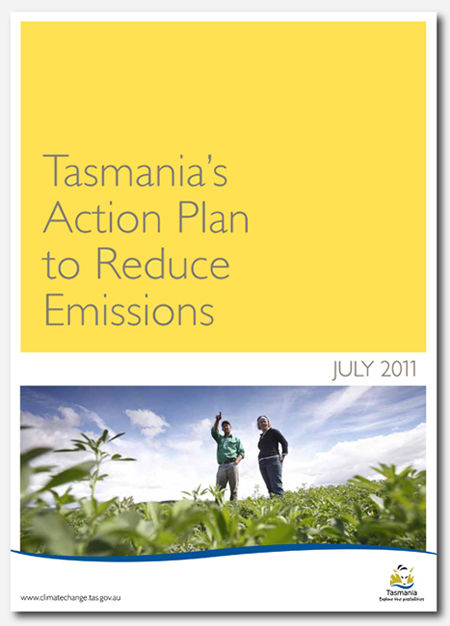Tasmania’s new climate-energy plan lacks the spark that could get us going. We can do better. [2 August 2011 | Peter Boyer]
 Tasmania is well placed to act decisively on climate change and lead the world in embracing a low-carbon future, the Tasmanian Climate Action Council told the government last year.
Tasmania is well placed to act decisively on climate change and lead the world in embracing a low-carbon future, the Tasmanian Climate Action Council told the government last year.
Citing Tasmania’s advantages, including hydro energy, potential energy efficiency gains and carbon-rich forests and agricultural lands, the TCAC recommended 50 actions to make the state a leader in halting and reversing the current upward trajectory of its emissions.
The long list included mandatory consideration of climate change in all government decisions, prevention of emission-intensive developments, strategies for renewable energy and energy efficiency, developing more sustainable agricultural practices, rationalising road and rail freight systems and reducing private car usage.
In March this year, TCAC chair Prof Kate Crowley presented Climate Change Minister Nick McKim with a case for the state to adopt a 2020 emissions reduction target of 25 per cent below 1990 levels, which would be Australia’s second most ambitious 2020 target after the ACT.
Then last week, two months after taking over from McKim as minister, Cassy O’Connor released a 24-page report with the encouraging title “Tasmania’s Action Plan to Reduce Emissions”.
“We must take action!” said O’Connor in her introduction to the plan. “There is no longer ambiguity [about the evidence], and there is no time to wait for others to show leadership before we take the lead ourselves.”
All well and good. O’Connor would seem to agree completely with the thrust of the TCAC reports, that Tasmania should be ahead of the field in cutting emissions. But now we come to the detail.
The opening statement signals the plan’s limitations. Specifying that it covers only the next two years, it identifies actions that are “immediately available and can achieve practical outcomes” and opportunities that are “cost effective and available to us now”.
The plan aims to prepare Tasmania for a carbon price (including much-needed focus on major energy users, where big savings can be made), further develop renewable energy , account for forest carbon (welcome and much overdue), and consider short-term targets for reducing emissions.
Schemes to improve energy efficiency in public buildings, businesses and homes are at the heart of the plan, where they should be. Supporting people — especially low-income earners and pensioners — in reducing energy usage is paramount in these times of rapidly-rising power bills.
In addition, the government says it will examine current legislation to see what needs changing, identify longer term actions needed to reduce transport emissions, improve planning processes and get a better handle on agricultural emissions.
These are laudable intentions, but the road to hell is paved with them. This is a plan for a plan, with a truly miserly bottom line. Excluding the previously-announced Renewable Energy Loans Scheme ($30 million over four years), the plan’s budget adds up to a paltry $7.43 million, available over varying periods from one to four years.
Cost limitations are everywhere, such as the five-star green-building goal when the rest of Australia is moving to six stars, or the decision merely to “consider” a short term emission reduction target.
This is disappointing. It is now three years since the government’s much-vaunted Climate Change (State Action) Act promised rapid and decisive action to cut emissions, and 18 months since the “Wedges” analysis was presented to minister Lisa Singh.
Tasmanians need a plan that will inform and help direct their efforts to lower emissions, giving them confidence that their government grasps what is needed and after some hard thinking has come up with clear short- and long-term pathways. This plan provides no such assurance.
What we don’t need is the spin (which hides nothing) or the fancy graphics or the pretence that “government knows”. We just need a clear, unvarnished picture of what we all — government, business and the rest of us — need to do, separately and together.
If O’Connor really believes the task is important and leadership is called for, she should not have released the plan in its present form and under its somewhat misleading title. Cabinet may have watered down her submission; if so she should have withdrawn it and prepared to fight another day.
Perhaps I expect too much. The state’s drastically reduced GST revenue leading to draconian money saving measures would have severely restricted O’Connor’s room to move. We know — or if we don’t, we need to — that governments don’t have magic solutions to climate and energy issues. But why not come out and say that?
This needn’t be the end of the story. Tasmania may be in a parlous financial state, but that shouldn’t stop original thinking and cooperative, creative endeavour — all of which become possible if the net is cast wide enough into the public domain. O’Connor needs to take a breath and take further, broader counsel. If she’s able to do this she’ll finish up with a much better plan.
I don’t doubt O’Connor’s personal commitment to this challenge, but that calls into question the engagement of the government as a whole. Lara Giddings and her team have no greater task than to prepare for a post-carbon Tasmania. As yet, I’ve seen no evidence that the Premier grasps this.
